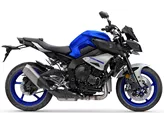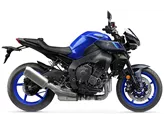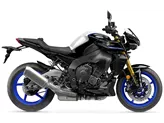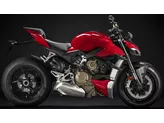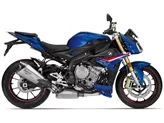Yamaha MT-10 2017 vs. Suzuki GSR 750 2017

Yamaha MT-10 2017

Suzuki GSR 750 2017
Overview - Yamaha MT-10 2017 vs Suzuki GSR 750 2017
The Yamaha MT-10 2017 and the Suzuki GSR 750 2017 are both naked bikes with similar engine types, inline 4-cylinder engines. However, there are several differences between the two models in terms of their technical specifications and overall performance.
In terms of engine power, the Yamaha MT-10 takes the lead with 160 HP compared to the Suzuki GSR 750's 106 HP. This significant difference in power output gives the Yamaha MT-10 a clear advantage in terms of acceleration and top speed. Additionally, the Yamaha MT-10 has a higher torque of 111 Nm compared to the Suzuki GSR 750's 80 Nm, which further enhances its overall performance.
Both bikes have similar chassis types, with the Yamaha MT-10 featuring an aluminum Deltabox frame and the Suzuki GSR 750 having a steel Twin Tube frame. The aluminum frame of the Yamaha MT-10 provides a lightweight and rigid structure, contributing to its agile handling and stability. On the other hand, the steel frame of the Suzuki GSR 750 offers a sturdy and durable construction.

Yamaha MT-10 2017
In terms of braking performance, both bikes have double disk brakes at the front. However, the Yamaha MT-10 does not specify the type of brake system, while the Suzuki GSR 750 mentions that it requires a lot of manual force. This suggests that the braking system of the Yamaha MT-10 may be more responsive and easier to control.
In terms of dimensions and weights, there are some minor differences between the two models. The Yamaha MT-10 has a slightly narrower front tire width of 120 mm compared to the Suzuki GSR 750's 120 mm. Both bikes have the same front and rear tire diameter of 17 inches. The Yamaha MT-10 has a slightly wider rear tire width of 190 mm compared to the Suzuki GSR 750's 180 mm. The wheelbase of the Yamaha MT-10 is 1400 mm, while the Suzuki GSR 750 has a slightly longer wheelbase of 1450 mm. The seat height of the Yamaha MT-10 is 825 mm, while the Suzuki GSR 750 has a slightly lower seat height of 815 mm. Both bikes have a similar fuel tank capacity of around 17 liters.

Suzuki GSR 750 2017
In terms of strengths, the Yamaha MT-10 is praised for its great sound, pleasant wind protection, comfortable seating position even on long tours, great engine response, and balanced overall package despite its radical looks and wicked sound. On the other hand, the Suzuki GSR 750 is commended for its attractive overall appearance, stable handling, successful tuning of the suspension elements, sufficient comfort, and easy-to-read instruments.
However, the Yamaha MT-10 does have some weaknesses. Its seating position is considered too inactive on the racetrack, and its chassis and ride assistance systems are deemed sufficient for track days but not on the same level as other Powernakeds. In comparison, the Suzuki GSR 750's weaknesses include a brake system that requires a lot of manual force and a box swingarm that is not particularly aesthetically pleasing.
In conclusion, the Yamaha MT-10 2017 offers superior engine power and torque, a lightweight and rigid aluminum frame, and potentially better braking performance. On the other hand, the Suzuki GSR 750 2017 has an attractive overall appearance, stable handling, and successful suspension tuning. Ultimately, the choice between the two models depends on individual preferences and priorities in terms of performance, aesthetics, and comfort.
Technical Specifications Yamaha MT-10 2017 compared to Suzuki GSR 750 2017
Pros and Cons in comparison
Pros and Cons in comparison
Yamaha MT-10 2017

The Yamaha MT-10 exudes a lot of emotion with the cool CP4 engine, but also doesn't forget pragmatic utility. For a naked bike, it offers a lot of comfort on long tours. It rides fast but is still refined at all times. On the racetrack, the chassis is not precise enough to beat the other Powernakeds. Overall, however, it scores with its versatility paired with radical looks and awesome sound.
Suzuki GSR 750 2017

A razor-sharp design with an aggressive front and narrow rear - just as speedy street raiders have always wanted. It is a pity that the rear swingarm was neglected (officially for weight reasons, unofficially for cost reasons), and the front dual-piston brake system seems a little weak. However, the performance during the ride, both at high speed and in tight corners, is quite good.
Price Comparison Avarage Market Price Yamaha MT-10 vs Suzuki GSR 750
There are a few key differences between a Yamaha MT-10 2017 and a Suzuki GSR 750 2017. There are the same number of bikes of both models available on the 1000PS.de marketplace, specifically 12. It takes less time to sell a Suzuki GSR 750 with 117 days compared to 143 days for the Yamaha MT-10. Since model year 2016 1000PS.de editors have written 32 reviews for the Yamaha MT-10 and 12 reviews for the Suzuki GSR 750 since model year 2011. The first review for the Yamaha MT-10 was published on 17/11/2015 and now has more than 20,700 views. This compares to more than 5,400 views for the first review on Suzuki GSR 750 published on 05/10/2010.



